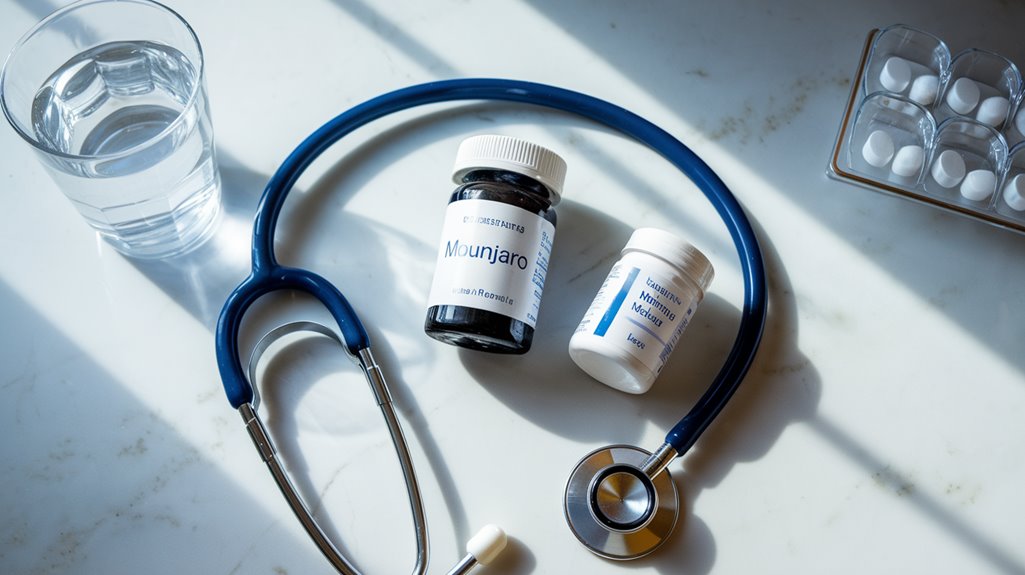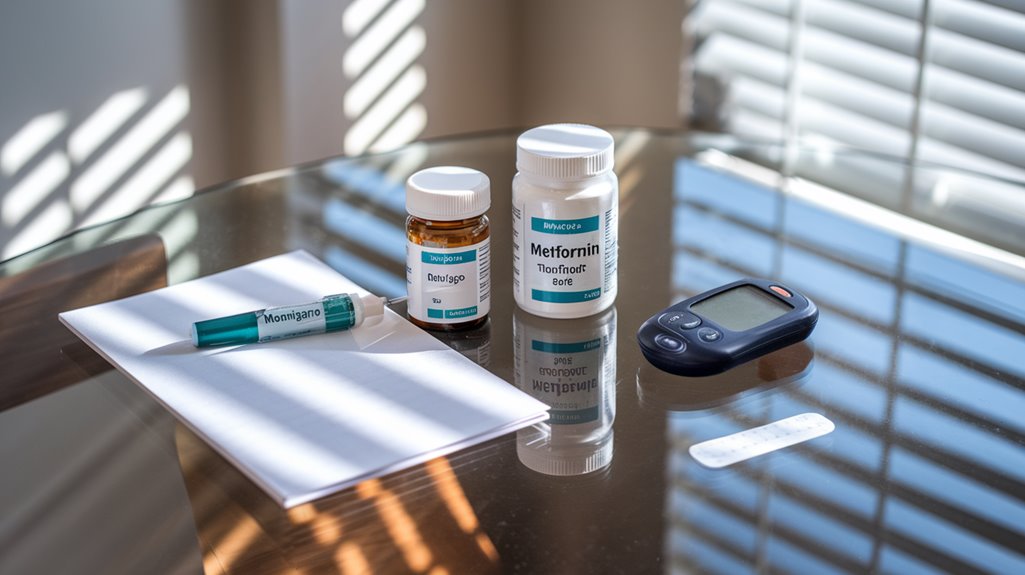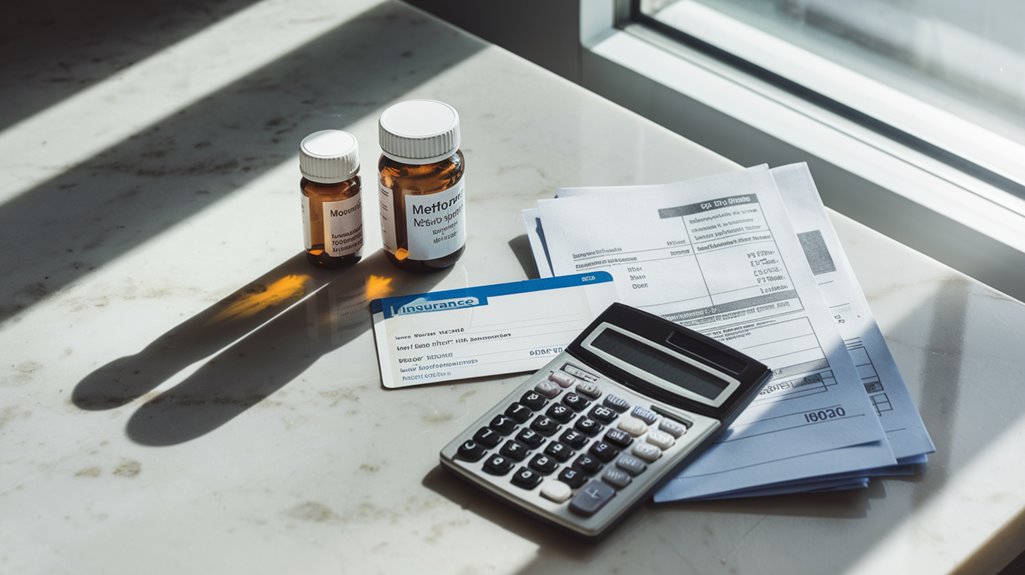Wondering why doctors are pairing Mounjaro with Metformin? This breakthrough diabetes combo delivers remarkable A1C reductions and weight loss results.

You'll find Mounjaro and Metformin working together as a powerful diabetes treatment combination, with clinical trials showing an impressive 2.5% reduction in A1C levels and up to 15% weight loss. Mounjaro's GLP-1 hormone mimicking effects complement Metformin's ability to decrease liver glucose production and improve insulin response. This FDA-approved duo requires careful dosing coordination with your healthcare provider, who can help you navigate potential side effects and maximize the synergistic benefits of this breakthrough treatment approach.
While both Mounjaro and Metformin target type 2 diabetes management, they work through distinct mechanisms to control blood sugar levels. Mounjaro functions by mimicking GLP-1, a natural hormone that increases insulin production, reduces liver sugar output, and regulates appetite. It's administered as a weekly injection and has shown significant effects on both blood sugar control and weight reduction. To maintain its effectiveness, Mounjaro must be stored in refrigeration between 36°F to 46°F.
Metformin, on the other hand, operates primarily by decreasing glucose production in your liver and improving your body's insulin response. It's taken orally and has established itself as a versatile medication, offering benefits beyond diabetes management, including potential cardiovascular protection and PCOS treatment. When prescribed together, these medications can complement each other's actions, though you'll need careful monitoring by your healthcare provider to manage potential side effects. Mounjaro commonly causes gastrointestinal effects, while Metformin requires attention to medication interactions and safety considerations.

The scientific synergy between Mounjaro and metformin creates a powerful dual-action approach to blood sugar control. While Mounjaro activates GIP/GLP-1 receptors to boost insulin secretion and curb appetite, metformin works at the cellular level by blocking mitochondrial complex I to reduce glucose production in your liver.
When you combine these medications, you'll benefit from their complementary mechanisms. Mounjaro enhances your body's insulin sensitivity and reduces food intake, while metformin decreases glucose production and improves how your cells utilize insulin. Clinical studies confirm that this combination leads to better A1C reductions than either medication alone. This powerful combination typically achieves A1C reductions over 2% when used together.
You'll also gain protection against diabetes complications through this all-encompassing approach. The combination can improve your cardiovascular health, help manage conditions like PCOS and fatty liver disease, and potentially slow the progression of type 2 diabetes, all while supporting meaningful weight loss.
Clinical evidence supporting Mounjaro-metformin combination therapy continues to mount through both controlled trials and real-world experiences. The data reveals impressive outcomes when these medications work together, particularly in achieving target blood sugar levels and weight management goals.
Key clinical findings demonstrate:
These results underscore why healthcare providers increasingly recommend this powerful combination for managing type 2 diabetes effectively. The medication's once weekly injection schedule makes it a convenient option for patients compared to daily diabetes medications.

When taking Mounjaro and metformin together, you'll need to actively manage common side effects like nausea and diarrhea through proper hydration and timing your medications with meals. You should watch for warning signs of drug interactions, particularly symptoms of hypoglycemia if you're also taking insulin or sulfonylureas. To prevent serious complications, it is crucial to monitor your kidney function regularly and report any severe stomach pain, allergic reactions, or unusual thyroid symptoms to your healthcare provider immediately. Both medications working together provide enhanced glucose control compared to using either medication alone.
Managing side effects from Mounjaro and metformin requires a proactive approach, as both medications commonly cause gastrointestinal issues that can impact daily life. You'll need to monitor your body's response and implement specific strategies to minimize discomfort. Mild side effects typically resolve within weeks as your body adjusts to the medication.
For injection site reactions with Mounjaro, rotate injection sites and keep the area clean. If you experience persistent side effects, consult your healthcare provider to adjust your treatment plan.
To minimize risks while taking Mounjaro and metformin together, a thorough safety protocol must be followed. You'll need regular check-ups to monitor your response and adjust dosages. It's essential to inform your healthcare provider about any medications you're taking to prevent harmful interactions. Since metformin and Mounjaro have no direct interactions between them, they can be safely used in combination when prescribed.
| Safety Measure | Action Required | Frequency |
|---|---|---|
| Blood Tests | Monitor glucose, kidney, liver function | Every 3-6 months |
| Provider Visits | Review symptoms, adjust medications | Every 3 months |
| Self-Monitoring | Check blood sugar levels | Daily |
| Health Tracking | Record side effects, symptoms | Ongoing |
Don't take these medications if you have severe kidney problems, liver disease, or a family history of medullary thyroid cancer. Watch for signs of hypoglycemia like dizziness or sweating, and seek immediate medical attention if you experience severe abdominal pain or persistent vomiting.
Patients taking Mounjaro and metformin must stay alert for critical warning signs of drug interactions. Watch for any sudden changes in your body's response to medication, particularly when starting treatment or adjusting dosages. Contact your healthcare provider immediately if you experience serious symptoms.
Key warning signs to monitor:
These warning signs require immediate medical attention. Your healthcare provider may need to adjust your medication regimen or implement additional monitoring protocols. Adjusting your eating habits to include smaller, frequent meals throughout the day can help manage digestive symptoms and reduce the risk of adverse reactions.

Getting started with the Mounjaro and metformin combination requires careful attention to proper dosing and administration protocols. You'll begin with a 2.5 mg weekly injection of Mounjaro, which can be increased to 5 mg after four weeks if needed, up to a maximum of 15 mg. You can take your injection at any time of day, with or without meals, rotating between your abdomen, thigh, or upper arm. Research shows that taking both medications together can help achieve normal HbA1c levels in over 84% of patients.
Before starting, you'll receive training on proper injection technique. It's essential to inspect your Mounjaro visually before each use and maintain a consistent weekly schedule. If you miss a dose, you can take it within 96 hours; otherwise, wait for your next scheduled injection. Your healthcare provider will monitor your response closely and adjust your medications as needed. Remember to report all medications you're taking to avoid potential interactions and guarantee ideal glycemic control through this combination therapy.

To optimize your Mounjaro and metformin treatment, you'll need to focus on three key lifestyle components: mindful eating habits, consistent exercise, and proper sleep with stress management. Your success with these medications considerably improves when you maintain nutrient-dense, portion-controlled meals while engaging in at least 150 minutes of moderate physical activity weekly. Choosing lean protein sources from foods like seafood, eggs, nuts, and soy products helps support healthy weight management. Quality sleep and effective stress management techniques further enhance treatment outcomes by supporting metabolic health and blood sugar regulation.
While taking Mounjaro and metformin helps regulate blood sugar levels, mindful eating habits play an essential role in maximizing treatment benefits. By implementing structured eating practices, you'll enhance your medication's effectiveness and support sustainable weight management.
Consistently practicing these mindful eating strategies alongside your medication regime will optimize your treatment outcomes.
Regular exercise serves as a powerful catalyst when combined with Mounjaro and metformin therapy, greatly enhancing their effectiveness for weight management and blood sugar control. While Mounjaro helps suppress appetite, exercise accelerates fat loss and builds lean muscle mass, creating a synergistic effect.
You'll want to incorporate both cardio and strength training into your routine, as this combination optimizes metabolic health and insulin sensitivity. Start at a manageable pace and gradually increase intensity as your fitness improves. Remember that exercise stimulates the production of lac-phe, an appetite-suppressing molecule that complements Mounjaro's effects.
Track your progress regularly and maintain consistency in your workout routine. Stay hydrated and combine exercise with a balanced, protein-rich diet to maximize results. Keep in mind that sustainable weight loss requires this thorough approach.
Successful management of your Mounjaro and metformin therapy depends heavily on quality sleep and stress control, as both factors greatly impact blood glucose regulation and weight loss outcomes.
To optimize your treatment results, implement these evidence-based strategies:
Poor sleep creates a vicious cycle, increasing hunger hormones and reducing exercise motivation. When combined with stress, these factors can greatly diminish your medication's effectiveness and compromise treatment outcomes.

Understanding the cost and insurance coverage for Mounjaro and metformin reveals notable differences between these medications. Mounjaro costs approximately $1,200 per month, while metformin typically ranges from $15-$20 monthly. For patients with commercial insurance, Eli Lilly offers a savings card that can reduce Mounjaro's cost to $25 for up to three months.
Insurance coverage varies notably between the two medications. Metformin, being generic, is widely covered by most insurance plans, including Medicare Part D. However, Mounjaro often requires prior authorization and may not be covered for off-label weight loss use. The manufacturer's savings card isn't available for patients with government insurance like Medicare or Medicaid.
You'll need to verify your specific insurance coverage and explore cost-saving options. While Mounjaro's cost may be prohibitive for some patients, discount programs and savings cards can make it more accessible if you qualify. Metformin remains the more economical choice for most patients.

While cost considerations shape initial treatment decisions, the long-term health benefits of combining Mounjaro and metformin demonstrate considerable clinical value. This dual therapy approach offers extensive management of Type 2 diabetes while delivering substantial metabolic improvements.
Clinical data reveals four key long-term benefits:
You'll experience more effective blood sugar regulation with this combination than with either medication alone. The partnership between Mounjaro's multi-angle glucose control and metformin's established benefits creates a powerful therapeutic alliance. This combination therapy can considerably reduce your risk of diabetes complications while improving overall metabolic health, making it a valuable long-term treatment strategy.

Regular monitoring and systematic adjustments form the cornerstone of effective Mounjaro and metformin combination therapy. You'll need to track several key metrics, including your blood sugar levels, weight changes, A1C levels, and cholesterol profiles. Your healthcare provider will use these measurements to assess treatment efficacy and make necessary modifications to your treatment plan.
Your Mounjaro dosage will typically start at 2.5 mg weekly and may increase gradually every four weeks up to 15 mg, while metformin dosing can range up to 2550 mg daily for immediate-release forms. You'll work closely with your healthcare provider to coordinate these medications' schedules and adjust doses based on your response and tolerance. Watch for potential side effects, particularly gastrointestinal symptoms, and report any concerns promptly. If you're taking other medications, make sure your healthcare provider knows about them to prevent dangerous interactions, especially with insulin or insulin secretagogues that could increase hypoglycemia risk.
The synergistic combination of Mounjaro and Metformin represents a quantum leap in diabetes management. You'll find this therapeutic dyad particularly efficacious when coupled with proper lifestyle modifications. While monitoring glycemic indices remains paramount, you're now equipped with a treatment modality that's truly greater than the sum of its parts. Consult your endocrinologist to determine if this au courant protocol aligns with your clinical requirements.